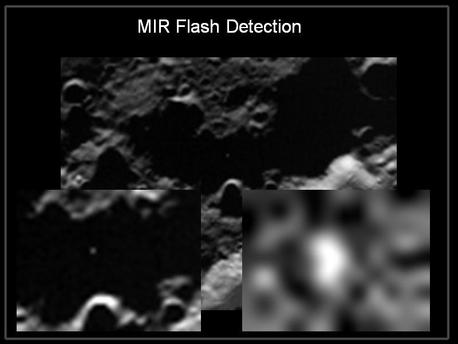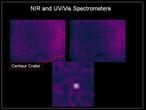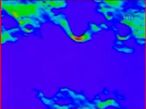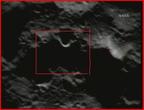LCROSS Mission Update
In Search for Water Ice
 © NASA Ames
|
The LCROSS mid-infrared (MIR) Camera detected a sodium flash at Centaur Impact.
"The LCROSS science instruments worked exceedingly well and returned a wealth of data that will greatly improve our understanding of our closest celestial neighbor," said Anthony Colaprete scientist at NASA'. "The team is excited to dive into data."
In preparation for impact, LCROSS and its spent Centaur upper stage rocket separated about 54,000 miles above the surface of the moon on Thursday at approximately 6:50 p.m. PDT.
Moving at a speed of more than 1.5 miles per second, the Centaur hit the lunar surface shortly after 4:31 a.m. Oct. 9, creating an impact that instruments aboard LCROSS observed for approximately four minutes. LCROSS then impacted the surface at approximately 4:36 a.m.
"This is a great day for science and exploration," said Doug Cooke, associate administrator for the Exploration Systems Mission Directorate at NASA Headquarters in Washington. "The LCROSS data should prove to be an impressive addition to the tremendous leaps in knowledge about the Moon that have been achieved in recent weeks. I want to congratulate the LCROSS team for their tremendous achievement in development of this low cost spacecraft and for their perseverance through a number of difficult technical and operational challenges."
Other observatories reported capturing both impacts. The data will be shared with the LCROSS science team for analysis. The LCROSS team expects it to take several weeks of analysis before it can make a definitive assessment of the presence or absence of water ice.
The images and video collected by the amateur astronomer community and the public also will be used to enhance our knowledge about the moon.
"One of the early goals of the mission was to get as many people to look at the LCROSS impacts in as many ways possible, and we succeeded," said Jennifer Heldmann, Ames' coordinator of the LCROSS observation campaign. "The amount of corroborated information that can be pulled out of this one event is fascinating."
The LCROSS mission could pioneer a series of small robotic missions on a smaller budget.
Source: NASA
LCROSS Mission Update
In Search for Water Ice
 © NASA Ames
|
The LCROSS mid-infrared (MIR) Camera detected a sodium flash at Centaur Impact.
"The LCROSS science instruments worked exceedingly well and returned a wealth of data that will greatly improve our understanding of our closest celestial neighbor," said Anthony Colaprete scientist at NASA'. "The team is excited to dive into data."
In preparation for impact, LCROSS and its spent Centaur upper stage rocket separated about 54,000 miles above the surface of the moon on Thursday at approximately 6:50 p.m. PDT.
Moving at a speed of more than 1.5 miles per second, the Centaur hit the lunar surface shortly after 4:31 a.m. Oct. 9, creating an impact that instruments aboard LCROSS observed for approximately four minutes. LCROSS then impacted the surface at approximately 4:36 a.m.
"This is a great day for science and exploration," said Doug Cooke, associate administrator for the Exploration Systems Mission Directorate at NASA Headquarters in Washington. "The LCROSS data should prove to be an impressive addition to the tremendous leaps in knowledge about the Moon that have been achieved in recent weeks. I want to congratulate the LCROSS team for their tremendous achievement in development of this low cost spacecraft and for their perseverance through a number of difficult technical and operational challenges."
Other observatories reported capturing both impacts. The data will be shared with the LCROSS science team for analysis. The LCROSS team expects it to take several weeks of analysis before it can make a definitive assessment of the presence or absence of water ice.
The images and video collected by the amateur astronomer community and the public also will be used to enhance our knowledge about the moon.
"One of the early goals of the mission was to get as many people to look at the LCROSS impacts in as many ways possible, and we succeeded," said Jennifer Heldmann, Ames' coordinator of the LCROSS observation campaign. "The amount of corroborated information that can be pulled out of this one event is fascinating."
The LCROSS mission could pioneer a series of small robotic missions on a smaller budget.
Source: NASA









